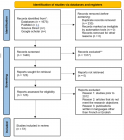Abstract
Research Article
The different levels of depression and anxiety among Pakistani professionals
Sehrish Hassan* and Waqar Husain
Published: 05 March, 2020 | Volume 4 - Issue 1 | Pages: 012-018
The present study was conducted to examine the relationship between work-stress, depression and anxiety among six major professionals (doctors, engineers, bankers, nurses, teachers, and lawyers). The inquiry included 260 professionals from different private and governmental sector organizations of Rawalpindi and Islamabad, Pakistan. Job Stress Scale and the subscales of Depression, Anxiety & Stress Scale for depression and anxiety were administered. Based on the hypotheses, a strong positive correlation was found between work stress and depression & anxiety. The current study revealed that stress at work not only prevailed among different Pakistani professionals on severely alarming levels but significantly contributed in developing depression and anxiety.
Read Full Article HTML DOI: 10.29328/journal.ida.1001014 Cite this Article Read Full Article PDF
Keywords:
Work stress; Depression; Anxiety
References
- Parker DF, DeCotiis TA. Organizational Determinants of Job Stress. Organizational Behavior and Human Performance. 1983; 32: 160-177.
- Lovibond PF, Lovibond SH. The structure of negative emotional states: Comparison of the Depression Anxiety Stress Scales (DASS) with the Beck Depression and Anxiety Inventories. Behav Res Ther. 1995; 33: 335-343. PubMed: https://www.ncbi.nlm.nih.gov/pubmed/7726811
- Khaled B, Al-Shammari IS, Jefri OA. Occupational Stress in Different Organizations: A Saudi Arabian Survey. Electronic Version. J Managerial Psychology. 1995; 10: 24-28.
- Levav I, Rutz W. World Health Organization: The world health report 2001 - Mental Health: New understanding, New Hope. Isr J Psychiatry Relat Sci. 2002; 39: 50-56. PubMed: https://www.ncbi.nlm.nih.gov/pubmed/12013710
- American Psychiatric Association. Diagnostic and statistical manual of mental disorders (5th Ed.). Washington, DC. 2013.
- American Psychiatric Association. Diagnostic and statistical manual of mental disorders (4th ed., text rev.). Washington, DC. 2000.
- Tennant C. Work-related stress and depressive disorders. J Psychosom Res. 2011; 51: 697–704. PubMed: https://www.ncbi.nlm.nih.gov/pubmed/11728512
- Melchio M, Caspi A, Milne BJ, Danese A, Poulton R, et al. Work stress precipitates depression and anxiety in young, working women and men. Psychol Med. 2007; 37:1119-1129. PubMed: https://www.ncbi.nlm.nih.gov/pubmed/17407618
- Larisch M, Joksimovic L, Starke D, Siegrist J. Effort-reward imbalance at work and depressive symptoms-a cross-sectional investigation of middle-aged employees. Psychother Psychosom Med Psychol. 2003; 53: 223–228. PubMed: https://www.ncbi.nlm.nih.gov/pubmed/12709890
- Godin I, Kittel F, Coppieters Y, Siegrist J. A Prospective Study of Cumulative Job Stress in Relation to Mental Health. BMC Public Health. 2005; 5: 67. PubMed: https://www.ncbi.nlm.nih.gov/pubmed/15958170
- Siegrist J, Starke D, Chandola T, Godin I, Marmot M, et al. The measurement of effort-reward imbalance at work: European comparisons. Soc Sci Med. 2004; 58: 1483–1499. PubMed: https://www.ncbi.nlm.nih.gov/pubmed/14759692
- Siegrist J. Adverse Health Effects of High Effort/Low Reward Condition. J Occup Health Psychol. 1996; 1: 27-41. PubMed: https://www.ncbi.nlm.nih.gov/pubmed/9547031
- Lovibond SH, Lovibond PF. Manual for the Depression Anxiety Stress Scales. (2nd. Ed.) Sydney: Psychology Foundation. 1995.
- Lovibond P. Long-term stability of depression, anxiety and stress syndromes. J Abnorm Psychol. 1998; 107: 520–526. PubMed: https://www.ncbi.nlm.nih.gov/pubmed/9715586
- French JRP, Caplan RD, Van Harrison R. The Mechanisms of Job Strain Stress & Strain. Chichester, UK: Wiley. 1982.
- Karasek RA. Job demands, job decision latitude, and mental strain: Implications for job redesign. Administrative Science Quarterly. 1979; 24: 285-308.
- Kawakami N, Iwata N, Tanigawa T, Oga H, Araki S, et al. Prevalence of mood and anxiety disorders in a working population in Japan. J Occup Environ Med. 1996; 38: 899–905. PubMed: https://www.ncbi.nlm.nih.gov/pubmed/8877839
- Iliceto P, Pompili M, Spencer-Thomas S, Ferracuti S, Erbuto D, et al. Occupational stress and psychopathology in health professionals: an explorative study with the multiple indicators multiple causes (MIMIC) model approach. Stress. 2013; 16: 143-152. PubMed: https://www.ncbi.nlm.nih.gov/pubmed/22632290
- Beehr TA, Franz TM. The current debate about the meaning of job stress. In J. M. Ivancevich & D. C. Ganster (Eds.), Job Stress: From Theory to Suggestion. New York: The Haworth Press, 5–18. Desmarais S, Alksnis C. Gender Issues. In J. Barling, E. K. Kelloway, & M. R. Frone (Eds.), Handbook of Work Stress. 1987.
- Kam-Weng B, Kwok-Bun C, Yiu-Chung K, Lee-Gan G, Geok-Choo L. Work stress and Psychological Well-being among Nurses. In Kwok-bun, C. Work Stress and Coping among Professionals.
- Stansfeld SA, Fuhrer R, Shipley M, Marmot M. Work characteristics predict psychiatric disorder: prospective results from the Whitehall II Study. Occup Environ Med. 1999; 56: 302–307. PubMed: https://www.ncbi.nlm.nih.gov/pubmed/10472303
- Fuhrer R, Stansfeld SA, Chemali J, Shipley MJ. Gender, social relations and mental health: prospective findings from an occupational cohort (Whitehall II study). Soc Sci Med. 1999; 48: 77–87. PubMed: https://www.ncbi.nlm.nih.gov/pubmed/10048839
- Andrea H, Bültmann U, van Amelsvoort LGPM, Kant Y. The incidence of anxiety and depression among employees—the role of psychosocial work characteristics. Depress Anxiety. 2009; 26: 1040–1048. PubMed: https://www.ncbi.nlm.nih.gov/pubmed/19242984
- Kaori Y, Norio S, Norio Y, Kazuma D, Hanako F, et al. Relationship between occupational stress and depression among psychiatric nurses of Japan. Arch Environ Occup Health. 2016; 71: 10-15. PubMed: https://www.ncbi.nlm.nih.gov/pubmed/25148581
Similar Articles
-
Burnout and Related Factors in Caregivers of outpatients with SchizophreniaHatice Demirbas*,Erguvan Tugba Ozel Kizil. Burnout and Related Factors in Caregivers of outpatients with Schizophrenia. . 2017 doi: 10.29328/journal.hda.1001001; 1: 001-011
-
Multi-factorial Depressive Disorders Need Multi-dimensional InterventionsMustafa Melih Bilgi*. Multi-factorial Depressive Disorders Need Multi-dimensional Interventions. . 2017 doi: 10.29328/journal.hda.1001002; 1: 012-014
-
Anxiety and depression as an effect of birth order or being an only child: Results of an internet survey in Poland and GermanyJochen Hardt*,Lisa Weyer,Malgorzata Dragan,Wilfried Laubach. Anxiety and depression as an effect of birth order or being an only child: Results of an internet survey in Poland and Germany. . 2017 doi: 10.29328/journal.hda.1001003; 1: 015-022
-
May we feed cancer?Maria Grazia Spurio*. May we feed cancer?. . 2018 doi: 10.29328/journal.ida.1001005; 2: 001-006
-
Vestibular-limbic relationships: Brain mappingPaolo Gamba*. Vestibular-limbic relationships: Brain mapping. . 2018 doi: 10.29328/journal.ida.1001006; 2: 007-013
-
Responding to Disasters: More than economic and infrastructure interventionsDavid Crompton OAM*,Ross Young,Jane Shakespeare-Finch,Beverley Raphael AM. Responding to Disasters: More than economic and infrastructure interventions. . 2018 doi: 10.29328/journal.ida.1001007; 2: 014-028
-
Mindset kinetics and some depression status: A new quantitative model under biochemical - toxicology approach?Luisetto M*,Ghulam Rasool Mashori,Behzad Nili-Ahmadabadi,Farhan Ahmad Khan,Kausar Rehman Khan. Mindset kinetics and some depression status: A new quantitative model under biochemical - toxicology approach?. . 2018 doi: 10.29328/journal.ida.1001008; 2: 029-039
-
Anti-anxiety effects in mice following acute administration of Ficus Thonningii (wild fig)Aduema W*,Akunneh-Wariso C,Ejiofo DC,Amah AK. Anti-anxiety effects in mice following acute administration of Ficus Thonningii (wild fig). . 2018 doi: 10.29328/journal.ida.1001009; 2: 040-047
-
Sleeplessness and healthSunitha V,Jeyastri Kurushev,Felicia Chitra,Manjubala Dash*. Sleeplessness and health. . 2019 doi: 10.29328/journal.ida.1001010; 3: 001-007
-
Translation, adaptation and validation of Depression, Anxiety and Stress Scale in UrduWaqar Husain*,Amir Gulzar. Translation, adaptation and validation of Depression, Anxiety and Stress Scale in Urdu. . 2020 doi: 10.29328/journal.ida.1001011; 4: 001-004
Recently Viewed
-
Advancing Forensic Approaches to Human Trafficking: The Role of Dental IdentificationAiswarya GR*. Advancing Forensic Approaches to Human Trafficking: The Role of Dental Identification. J Forensic Sci Res. 2025: doi: 10.29328/journal.jfsr.1001076; 9: 025-028
-
Scientific Analysis of Eucharistic Miracles: Importance of a Standardization in EvaluationKelly Kearse*,Frank Ligaj. Scientific Analysis of Eucharistic Miracles: Importance of a Standardization in Evaluation. J Forensic Sci Res. 2024: doi: 10.29328/journal.jfsr.1001068; 8: 078-088
-
Sinonasal Myxoma Extending into the Orbit in a 4-Year Old: A Case PresentationJulian A Purrinos*, Ramzi Younis. Sinonasal Myxoma Extending into the Orbit in a 4-Year Old: A Case Presentation. Arch Case Rep. 2024: doi: 10.29328/journal.acr.1001099; 8: 075-077
-
Toxicity and Phytochemical Analysis of Five Medicinal PlantsJohnson-Ajinwo Okiemute Rosa*, Nyodee, Dummene Godwin. Toxicity and Phytochemical Analysis of Five Medicinal Plants. Arch Pharm Pharma Sci. 2024: doi: 10.29328/journal.apps.1001054; 8: 029-040
-
Antibacterial Screening of Lippia origanoides Essential Oil on Gram-negative BacteriaRodrigo Marcelino Zacarias de Andrade, Bernardina de Paixão Santos, Roberson Matteus Fernandes Silva, Mateus Gonçalves Silva*, Igor de Sousa Oliveira, Sávio Benvindo Ferreira, Rafaelle Cavalcante Lira. Antibacterial Screening of Lippia origanoides Essential Oil on Gram-negative Bacteria. Arch Pharm Pharma Sci. 2024: doi: 10.29328/journal.apps.1001053; 8: 024-028.
Most Viewed
-
Evaluation of Biostimulants Based on Recovered Protein Hydrolysates from Animal By-products as Plant Growth EnhancersH Pérez-Aguilar*, M Lacruz-Asaro, F Arán-Ais. Evaluation of Biostimulants Based on Recovered Protein Hydrolysates from Animal By-products as Plant Growth Enhancers. J Plant Sci Phytopathol. 2023 doi: 10.29328/journal.jpsp.1001104; 7: 042-047
-
Sinonasal Myxoma Extending into the Orbit in a 4-Year Old: A Case PresentationJulian A Purrinos*, Ramzi Younis. Sinonasal Myxoma Extending into the Orbit in a 4-Year Old: A Case Presentation. Arch Case Rep. 2024 doi: 10.29328/journal.acr.1001099; 8: 075-077
-
Feasibility study of magnetic sensing for detecting single-neuron action potentialsDenis Tonini,Kai Wu,Renata Saha,Jian-Ping Wang*. Feasibility study of magnetic sensing for detecting single-neuron action potentials. Ann Biomed Sci Eng. 2022 doi: 10.29328/journal.abse.1001018; 6: 019-029
-
Pediatric Dysgerminoma: Unveiling a Rare Ovarian TumorFaten Limaiem*, Khalil Saffar, Ahmed Halouani. Pediatric Dysgerminoma: Unveiling a Rare Ovarian Tumor. Arch Case Rep. 2024 doi: 10.29328/journal.acr.1001087; 8: 010-013
-
Physical activity can change the physiological and psychological circumstances during COVID-19 pandemic: A narrative reviewKhashayar Maroufi*. Physical activity can change the physiological and psychological circumstances during COVID-19 pandemic: A narrative review. J Sports Med Ther. 2021 doi: 10.29328/journal.jsmt.1001051; 6: 001-007

HSPI: We're glad you're here. Please click "create a new Query" if you are a new visitor to our website and need further information from us.
If you are already a member of our network and need to keep track of any developments regarding a question you have already submitted, click "take me to my Query."



















































































































































